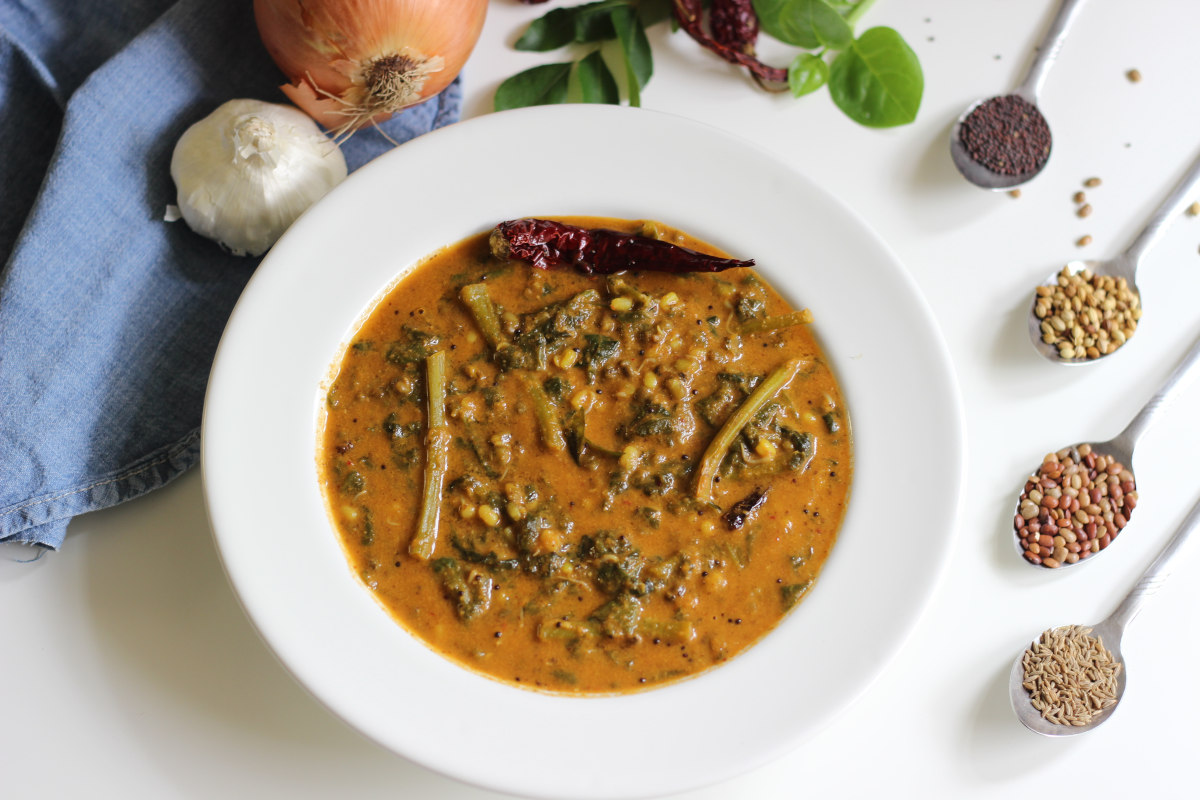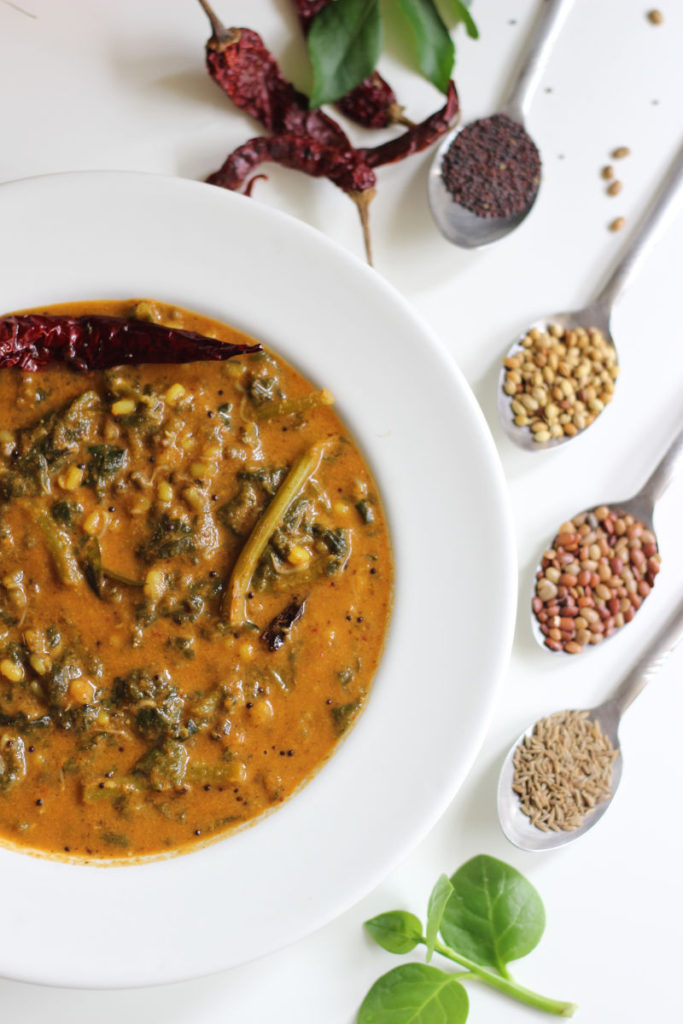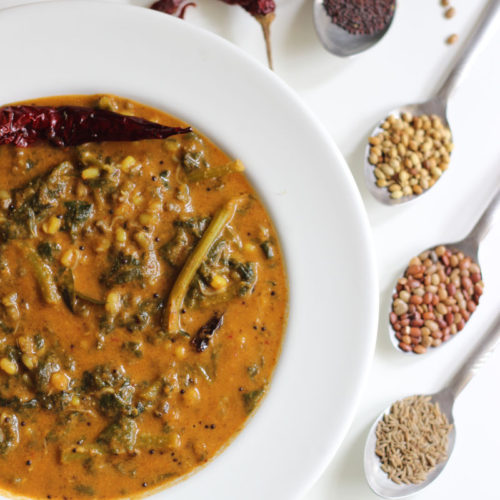Malabar spinach curry | basale soppu sambar

Basale soppu sambar, called Basale bendi in Havyaka language is one of my most favourite curries, especially when prepared using this awesome recipe from my mom. My mom’s basale soppu sambar recipe does require freshly toasted spices along with sauteed onions and garlic but it is so worth the extra effort! The generously used browned garlic and onions add a great depth of flavour. This Mangalore style malabar spinach recipe uses a different mix of spices compared to other recipes, I highly recommend you give this a try! This coconut based curry is vegan too!
Basale soppu – malabar spinach
Sambar – a south Indian curry
Basale sambar/bendi which is also called basale koddel can be paired with matta rice or can also be served with white rice. It goes exceptionally well with breakfast dishes like neeru dose, akki rotti(rice flour roti) and with Mangalorean rice dumplings called unde/pundi. Growing up, mom used to make huge potfuls of malabar spinach curry to go with unde/pundi and neer dose and it used to vanish pretty quickly! So good!

Ingredients used to make Basale soppu sambar
Malabar spinach
Malabar spinach, called basale soppu in Mangalore, is a special variety of spinach. In North America, I am sometimes able to find it at Indian and Asian grocery stores. Regular spinach/palak can be used too.
Vegetables and beans, as a mix-in
Basale soppu sambar tastes great with a vegetable or bean as a mix in. The vegetables that are generally used in basale bendi are unripe(kaayi) papaya or bottle gourd(sorekai/lauki). In my video, I have used cooked jackfruit seeds as a mix-in.
Beans like black eyed peas(alasande beeja) or any kind of white beans(like canellini, lima) can be used as a mix in. Soak and cook the beans separately with salt. Add cooked beans into the curry when the veggies are cooked. Sprouted mung beans can also be added to malabar spinach curry. Sprouted mung beans do not have to be cooked separately as they take lesser time to cook and can cook along with the vegeteables.
Homemade masala paste
All the ingredients used in the masala paste can be found at an Indian grocer or you could also buy them online.
Fresh coconut
As with majority of the curries from the Mangalore region, this curry too is thickened using fresh coconut. As Havyaka community hails from regions with plenty of coconut trees, coconut is the go-to thickener in majority of Havyaka recipes. I recommend using freshly grated or frozen coconut. Dry dessicated coconut isn’t something that is traditionally used and it would also alter the taste of the curry, but if you are in a pinch, feel free to use it.
Horsegram (Kudu/Huruli/Kulith)
Horsegram is one of the lesser known beans that when roasted gives a wonderful flavour to our basale koddel.
Dry red chillies
I recommend using Byadgi variety of dry red chillies. These are not very spicy and have a brighter colour. Kashmiri dry red chillies could be used too. If both these varieties are not available, you could use any other Indian variety.
Tamarind
Tamarind is a sour tropical fruit that is dried and used as a souring agent in many Indian recipes. Use either the dried fruit or the concentrate.
Other ingredients for masala paste
- Coriander seeds
- Black mustard seeds
- Onion
- Garlic – Lots of it!
How to serve Basale soppu sambar
Basale soppu sambar is served hot with rice. It also makes an excellent side for neeru dose, pundi/unde(steamed rice dumplings), akki ubbu rotti.
Check out these Havyaka recipes!
Havyaka recipes are generally easy to make and are mildly spiced. Check out these simple comfort foods!
- Tambuli – uncooked coconut & yogurt side
- Melara/majjige huli – Simplest coconut and yogurt based curry
- Palya/taalu – simple vegetable side dish
- More recipes here!
Don’t miss a recipe!
Please enter your email here and you will be notified of new recipes by email!
Basale soppu sambar recipe

Malabar spinach curry | basale soppu sambar
Equipment
- Heavy bottomed pan
Ingredients
- 6 cups malabar spinach/basale or use regular spinach(palak) instead
- 2 cups vegetable like unripe papaya kaayi papaya or bottle gourd/lauki/sorekai
- salt to taste
- ¼ tsp turmeric
- 1 tbsp jaggery unrefined Indian sugar
- 2 cups water adjust to your liking
- ¼ cup dry beans like black eyed peas, white beans or mung beans optional, about 1 cup cooked or canned.
For the masala paste
- ¾ cup fresh/frozen coconut
- 4 tsp coriander seeds kottambari/dhania
- ½ tsp cumin seeds jeerige/jeera
- ½ tsp black mustard seeds saasive
- 2 tsp horsegram kudu/huruli/kulith
- 4-5 dry red chillies preferably byadagi or kashmiri chillies, adjust to suit your taste
- ½ cup water
- ½ cup chopped onions
- 6 big cloves garlic or 12 small cloves
- ¾ tsp oil
- tamarind gooseberry/raspberry sized
For hot oil seasoning/tadka/oggarane
- 1-2 tsp oil preferably unrefined coconut oil
- 1 dry red chilli broken
- 1 sprig curry leaves optional
- ½ tsp black mustard seeds saasive
Instructions
- If using beans, soak the beans overnight and cook separately. Canned beans can be used too.
- De-frost coconut if using frozen.
Roasting the spices
- In a heavy bottomed pan, on medium heat, roast coriander seeds, mustard seeds, cumin seeds and dry red chillies in a few drops of oil, until toasted and fragrant. Take care not to burn the spices. Take these spices out onto a plate.
- In the same pan roast horsegram on medium heat until it changes colour and smells nicely toasted. It may also start to splutter. Take it out onto the plate.
- In half tsp of oil roast chopped onions and garlic until they are nicely golden. Some char on them is okay too.
Prepare coconut masala paste
- Add roasted spices, roasted horsegram, coconut, tamarind to a blender or mixer-grinder, with enough water to blend and blend into a smooth paste.Note: Coconut should be at room temperature. If not, use warm water so that fat from coconut doesn't separate.
Making the curry
- As spinach stalks take longer to cook, first cook the stalks in enough water.
- Add salt, turmeric. Cover and cook.
- When the stalks are half cooked, add chopped raw papaya or bottle gourd if using. Cover and cook.
- When vegetables are almost cooked, add malabar spinach.
- Add jaggery.
- Add cooked beans, if using.
- When the vegetables are cooked, add in the ground masala paste. Thin it with water to your desired consistency.
- Taste and adjust salt and jaggery to your liking.
- On medium heat bring the curry to a gentle boil, stirring occasionally.
- Cook for two more minutes and turn off the heat.
Hot oil seasoning/tadka/oggarane
- Heat oil in a small heavy bottomed pan.
- Add mustard seeds and broken red chilli.
- When mustard splutters, add curry leaves and pour the oil, along with the spices over the curry.
- Cover. Mix and serve with rice or rice rotti, neeru dose, unde/pundi
Video
Notes
- Remember to defrost and bring frozen coconut to room temperature before blending, to prevent the separation of fat.
- Tamarind concentrate can be used too. Add 1/2 tsp along with jaggery.
- Optionally, different kinds of beans can be used as an add-in. Soak and cook the beans separately and add into the curry.
- Horsegram – kudu, huruli, kulith
- Black eyed peas – alasande beeja
- Sprouted Green gram/Mung bean/Moong/Hssaru kaalu – sprouted moong does not need to be cooked separately, it cooks along with malabar spinach stalks.
- Cooked jackfruit seeds also make a nice add-in to basale sambar.
- Personally, I like this curry when the sweetness from jaggery comes through.
- As malabar spinach curry is prepared using fresh coconut, it needs refrigeration after a few hours, depending on how warm your kitchen is. If kitchen is very warm, you can refrigerate it in 6 hours.
Did you try this recipe?
Do leave a star rating and comment below to let me know how you liked it! I would love to see the photos too! Tag me on social media!
Thank you so much for stopping by! It really means a lot to me!
- Breakfast (19)
- Chutneys/Dips (11)
- Dessert (13)
- Havyaka cuisine (33)
- Indian (41)
- Lunch/Dinner (44)
- Recipes (70)
- Snacks (11)
- Vegan (54)
- Vegetarian (65)
I tried this along with taur dal and onion. Super taste and loved it .Thank u for this excellent receipe
I am so glad you liked it! Thanks a lot for taking the time to leave your feedback!
Tried this with sprouted moong beans. Very yummy and different from the regular fare we eat.
This was my first time eating Malabar spinach and the stalks turned out slimy when bitten into. Is that expected or did I overcook them?
Thank you for posting!
Thank you so much for trying the recipe and also for taking the time to leave a comment, it means the world to me! Am so happy that you liked it! Yes, malabar spinach stalks are naturally slimy, it’s not due to overcooking them.
Delicious.. loved it .. 1st time loved a sambhar without Dal. Something new something different..👏👍
Thank you SO much Jayashree for trying it out and for leaving your feedback. It made my day! Am so happy that you loved it, it is one of my favourites too! 🙂
Referred to this reciepe and made with different vegetable!
Loved it! Thanks Shwetha.
Wow! Am so happy you loved it! Thank you for letting me know, appreciate it! 🙂
This curry tastes so good! One of my all time favorites , never tried adding horsegram though. Will be trying that next time I make this 👍
Hope you like it with horsegram 🙂 Thank you!
Another excellent recipe. Use of garlic gives it a very good flavor.
Thank you! Am glad you liked it 🙂
I would use ಚಾಕು ಬಾಳೆಕಾಯಿ instead of papaya if I have it.
That’s something new for me to try! Thank you for the great suggestion. Will definitely be trying it 🙂